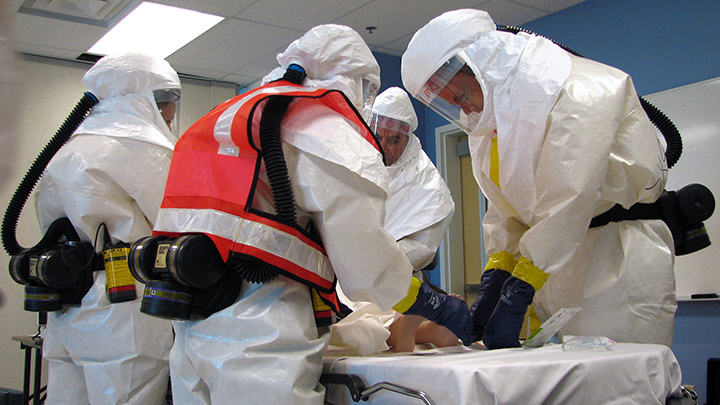
September 2, 2022

An Alberta Health Services educational program — known as CBRN/HazMat First Receiver training — teaches healthcare providers how to provide the best care for patients exposed to chemical, biological, radiological or nuclear hazardous materials. Photo courtesy of AHS.
Story by Sherri Gallant | Photo courtesy of AHS
When patients come to the emergency department after being exposed to a hazardous substance, the physicians and nurses who ensure their safety rely upon their hazardous materials (HazMat) training provided by Alberta Health Services.
The program — known as CBRN/HazMat First Receiver training — details how to provide the best care for patients exposed to chemical, biological, radiological or nuclear hazardous materials.
The training helps participants recognize and respond swiftly to exposures. This doesn’t just protect the patient, but also the staff, other patients and the care centre itself. The program makes use of web-based training as well as practical sessions to familiarize participants with Level C PPE (Personal Protective Equipment) response carts, triage totes and decontamination showers.
Jeff Dutton is director for Emergency Disaster Management in the South Zone. With Alberta being such an industrialized province, he notes that more staff have been signing up — and he’s hoping that trend continues.
“Before the program was implemented 10 years ago, we had several documented incidents provincially in which contaminated patients had shown up at emergency departments but weren't recognized as being such,” he says.
“They were recognized as being sick, but because it wasn’t immediately clear why, they made their way through triage into our care areas. At that point, we have nursing staff and physicians looking after this patient; the patient’s now in a hospital bed in our emergency department — so we had issues where staff and physicians were getting cross-contaminated from their patient.
“When someone's contaminated,” Dutton explains, “there's often a noxious odour to it — but not always. Imagine that going into the hospital. It's one thing if you're a healthy respiratory patient, but if you have someone who has asthma or COPD or pneumonia, if the noxious odor gets into our emergency department and they breathe it, that can have a profound impact.”
Dutton says the program was put in place to mitigate, prepare for, and prevent risks associated with potential contamination of staff, patients and care areas.
Exposure incidents, which happen in the home as well as in industry and agriculture, can range from mild to extremely dangerous or fatal.
“We've seen everything from anhydrous ammonia incidents, which is used extensively in agriculture and refrigeration, to organophosphate pesticides, household cleaning chemicals like bleach, and even pepper spray,” says Dutton.
“But one of the big ones was an anhydrous ammonia incident at a fertilizer plant. We had two patients come in from that; one with significant exposure and the other one was a moderate exposure.
“The EMS personnel had red eyes that were tearing, and they were coughing, but we were able to prevent that from happening at the emergency department because we got our nurses and respiratory therapists into PPE, and we were able to care for this person.”
Staff begin the HazMat education process through pre-requisite modules taken through My Learning Link (MLL); available for both clinical and non-clinical providers. These 90-minute courses teach staff how to protect themselves against CBRN/HazMat agents, and to safely respond and provide care during a CBRN/HazMat incident.
Practical training is then delivered on site (three hours) and aimed at acute and urgent care staff who may become first receivers in the event of a CBRN/HazMat incident. This includes clinical nursing staff, protective services, admitting staff and nuclear medicine technologists. In rural sites, this may also include local AHS or contracted EMS personnel. Physicians, clinical nurse educators and managers are also encouraged to take CBRN/HazMat First Receiver training, along with facilities maintenance and engineering staff and EMS personnel.
Skills are then kept current by means of a repeating two-year cycle to maintain readiness, with the MLL pre-requisite module and practical training session in year one, and a MLL refresher module in year two.
Front-line employees who are interested in signing up for CBRN/HazMat First Receiver training should talk to their supervisor, who can reach out to Dutton’s team directly for information.